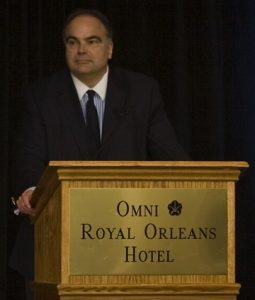 The Historic New Orleans Collection (HNOC) ranks as New Orleans’ premier center devoted to the study and preservation of the history of lower Louisiana and the Gulf Coast. The HNOC operates a complex of buildings in the French Quarter, including a museum and research center. Each year the HNOC holds an annual symposium open to the public. The Omni Royal Orleans Hotel hosted the fifteenth symposium, “Between Colony and State: Louisiana in the Territorial Period.” Organizers invited AHI co-founder Robert Paquette to speak about one of the most dramatic events during the period, a slave insurrection that broke out in the United States’ first major sugar-producing zone, about 30 miles upriver from New Orleans.
The Historic New Orleans Collection (HNOC) ranks as New Orleans’ premier center devoted to the study and preservation of the history of lower Louisiana and the Gulf Coast. The HNOC operates a complex of buildings in the French Quarter, including a museum and research center. Each year the HNOC holds an annual symposium open to the public. The Omni Royal Orleans Hotel hosted the fifteenth symposium, “Between Colony and State: Louisiana in the Territorial Period.” Organizers invited AHI co-founder Robert Paquette to speak about one of the most dramatic events during the period, a slave insurrection that broke out in the United States’ first major sugar-producing zone, about 30 miles upriver from New Orleans.
The insurrection, as Paquette pointed out, although the largest in US history, remains something of a mystery even to specialists. In 2009, the journal Historical Reflections invited him to publish an analysis of the event in a special issue devoted to historical understandings of collective violence. This article “A Horde of Brigands?: The Great Louisiana Slave Revolt of 1811 Reconsidered,” 35 (Spring 2009) forms the core of a forthcoming book on the subject.
Paquette discussed the event in front of an audience of 400. He spoke about the causes, content, and consequences of the insurrection, which, in part, reflected new understandings of the meaning of freedom in an age of democratic revolution. A rich folkloric tradition surrounds the event in lower Louisiana to this day, and Paquette attempted to separate fact from fiction in light of available evidence drawn from archival research on both sides of the Atlantic.
The HNOC, said Paquette, “is a world-class repository populated by first-class professionals. Their hospitality sets a high standard indeed.” The symposium closed with a sumptuous dinner with HNOC officers and trustees at Arnaud’s Restaurant on Bienville Street. “In addition to discussing Louisiana history,” Paquette added, “I received many questions from attendants about the AHI. Their interest was most gratifying.”

Leave A Comment